Correlation of Serum Zinc, Blood Glucose and Insulin Levels with Duration of Obesity in Children of Central China
Tao Zhua1* and Feng Lib2
1Department of Clinical Laboratory, The Fifth Affiliated Hospital, Zhengzhou University, China
2School of Mathematics and Statistics, Zhengzhou University, China
Submission: April 15, 2022; Published: July 08, 2022
*Corresponding author: Tao Zhu, Department of Clinical Laboratory, the Fifth Affiliated Hospital, Zhengzhou University, Zhengzhou, Henan, China
How to cite this article: Tao Z, Feng L. Correlation of Serum Zinc, Blood Glucose and Insulin Levels with Duration of Obesity in Children of Central China. Curre Res Diabetes & Obes J 2022; 15(5): 555925.DOI: 10.19080/CRDOJ.2022.15.555925
Abstract
Background: The nutritional status of zinc is altered in children with obesity and related to blood sugar metabolism.
Objectives: To investigate the correlation between the duration of childhood obesity with blood zinc, blood glucose and insulin levels.
Methods: The blood zinc, blood sugar and insulin levels were tested in 79 children with simple obesity examined between January 2016 and March 2018 at the Fifth Affiliated Hospital of Zhengzhou University, and 82 randomly selected non-obese children as the control group seen in the Department of Health of our hospital.
Results: The blood zinc, blood sugar and insulin levels of obese children were higher than that of the control group and showed greater fluctuation. The difference of zinc content and fasting insulin (FINS) content between the two groups was more prominent. The difference between homeostatic model assessment for insulin resistance (HOMA-IR) was most significant among the 3 groups with different duration of obesity after adjusting for age (F=93.866, p<0.0001), followed by difference in FINS (F=60.322, p<0.0001) also had significant statistical significance, while the difference of Zinc content between the 3 groups was not statistically significant (F=3.2742, p>0.05).
Conclusions: There was no statistically significant difference of gender distribution between obesity group and the control group. There was statistically significant difference of blood zinc and FINS levels between children with simple obesity and the control group. After adjusting for age, FINS and HOMA-IR showed statistically significant difference with different duration of obesity.
Conclusions: There was no statistically significant difference of gender distribution between obesity group and the control group. There was statistically significant difference of blood zinc and FINS levels between children with simple obesity and the control group. After adjusting for age, FINS and HOMA-IR showed statistically significant difference with different duration of obesity.Keywords: Nutritional status; Obesity; Blood sugar metabolism; Childhood obesity; Blood zinc; Insulin resistance; Atherosclerosis; Fasting plasma glucose; Skinfold thickness; Body fat mass; Lean body mass
Abbreviations: FINS: Fasting Insulin; HOMA-IR: Homeostatic Model Assessment for Insulin Resistance; WHO: World Health Organization; FPG: Fasting Plasma Glucose; BMI: Body Mass Index; CDC: Centers for Disease Control and Prevention; Zn: Zinc; DCVs: Dense Core Vesicles
Introduction
Simple obesity in children is an important risk factor for many chronic diseases. With the change in lifestyle and dietary structure, pediatric obesity is becoming epidemic globally. Pediatric obesity is a major problem in the Western Countries [1] and the incidence show steady increase in the developing countries. According to the World Health Organization (WHO), there were 41 million children with overweight or obesity under the age of 5 in 2016, with nearly half lived in Asia, and over 340 million children and adolescents aged 5-19 with overweight or obesity in 2016 [2]. In China, the prevalence of pediatric obesity was approximately 5-8%. Obesity is one of the major causes of many metabolic diseases [3,4]. Obesity is a chronic disease closely related to one’s lifestyle, with overeating and decreased physical activity resulting in accumulation of body fat. Pediatric obesity not only threatens the normal growth of children, but also is also a significant risk factor for the development of adult obesity, atherosclerosis and diabetes mellitus later in life. It is now a common disease that threatens children’s health. Zinc is an important trace mineral in human body and plays an important role in the normal development of children [5]. The nutritional status of zinc is altered in children with obesity [6,7] and is related to blood sugar metabolism [8]. To understand the relationship between blood zinc, glucose and insulin, in this study, we examined the blood zinc, fasting plasma glucose (FPG), fasting insulin (FINS) levels and homeostatic model assessment for insulin resistance (HOMA-IR) in 79 children with simple obesity and the duration of obesity ranging from half year to 13 years.
Methods
Clinical samples
79 children in central China with simple obesity examined between January 2016 and March 2018 at the Fifth Affiliated Hospital of Zhengzhou University were selected. There were 39 males and 40 females with age ranging from 3 years to 18 years (median: 12 years; and mean 12.05 years). The diagnosis of obesity was based on Body Mass Index (BMI) according to National Center for Health Statistics/Centers for Disease Control and Prevention (CDC). The BMI was calculated as weight in kilograms divided by the square of height in meters. Children with obesity were divided into three groups: mild obesity with BMI of 20-29% (n=29), moderate obesity with BMI of 30-39% (n=40), and severe obesity with BMI of 40-50% (n=10). The diagnosis of simple obesity was also based on measurement of skinfold thickness, body fat mass, lean body mass, circumference of different body parts, and exclusion of obesity induced by endocrine or genetic diseases through careful investigation of clinical and family history, physical examination and relevant lab and radiological tests. The duration of obesity of the 79 patients ranged from 0.5 years to 13.5 years. The duration of obesity was divided into three groups based on 25 percentile and 75 percentiles of years: group A with duration of obesity of 0.5~2.75 years, n=30, age range of 3~17 years; group B with duration of obesity of 2.75~5 years, n=30, age range of 5~16 years; group C with duration of obesity of 6-14 years, n=29, age range of 7~17 years. The control group included 82 randomly selected children without obesity seen in the Department of Health of our hospital. There were 41 males and 41 females, with age ranging from 7 years to 18 years (median: 12.5 years; mean: 12.23 years). Genetic, endocrine and cardiovascular diseases were excluded clinically, and lab tests showed no liver or pancreatic damage.
Methods
The levels of serum zinc (Zn) were analyzed using the BH5100 atomic absorption spectrum instrument and meters on 20μl peripheral blood. Serum FINS and FPG were measured on fasting serum by IMMULITE 1000 Automated Immunoassay Analyzer from Siemens and AU5800 Chemistry Analyzer from Beckman Coulter. HOMA-IR=FINS (mU/L) × FPG (mmol/L)/22.5. The reference range of the tests: FPG: 3.89~6.11mmol/L; FIN: 5~25mU/L, serum Zn: 62~110μmol/L (1~<2 years old), 66~120μmol/L≥2~<3years old, 72~130μmol/L 3~<5 years old≥76.5~140μmol/L≥5years old≥HOMA-IR≥2.69 was defined as insulin resistant.
Statistical analysis
R software was used for statistical analysis. FPG level was analyzed with multiple t-test. To visually compare the levels of our tests between children with obesity and the control group, we created box plots of the Zn, FPG, FINS and HOMA-IR levels of the two groups, and used variance analysis determined if their distribution in the three groups of simple obesity showed any statistical significance, after excluding the influence of covariate (age) on Zn, FPG, FINS and HOMA-IR. Before performing the variance analysis, the Zn, FPG, FINS and HOMA-IR levels in each group were tested by Bartlett’s variance homogeneity test. The results showed that the levels in different groups did not satisfy the homogeneous condition of variance, therefore, we used oneway test function to do the variance analysis. Eventually, we used multiple t-test to determine the Zn, FPG, FINS and HOMA-IR levels in which group showed statistically significant difference and mapped the t-test results based on the degree of difference.
Results
Difference in gender distribution and age
There were 39 males and 40 females in the group of children with obesity, and 41 males and 41 females in the control group. The t-value of the difference in ages between the group of children with obesity and control group was 0.3666, with a P-value of 0.7144. Therefore, there was no statistically difference between the ages of the two groups.
Comparison of differences of Zn, FPG, and FINS levels between children with obesity and without obesity
To visually compare the levels of Zn, FPG, and FINS between the group of children with obesity and the control group, we generated box plots (Figure 1-3). As seen in figure 1 & 3, the Zn, FPG, and FINS levels were significantly higher in children with obesity as compared to that of control group and showed greater fluctuation. The difference in Zn and FINS levels were more prominent.
Differences of Zn, FPG, FINS and HOMA-IR levels in three groups with different duration of obesity
The HOMA-IR showed most significance difference among the three groups of children with obesity (F = 93.866, P<0.0001), and followed by FIN (F = 60.332, P<0.0001), both showed statistical significance, Zn (F = 3.2742, P>0.05), FPG (F = 1.9067, P>0.05) (Figures 4-7). As seen in the box plots, the difference in HOMA-IA and FINS levels between the different groups was most obvious, which was consistent with results listed in the table 1.
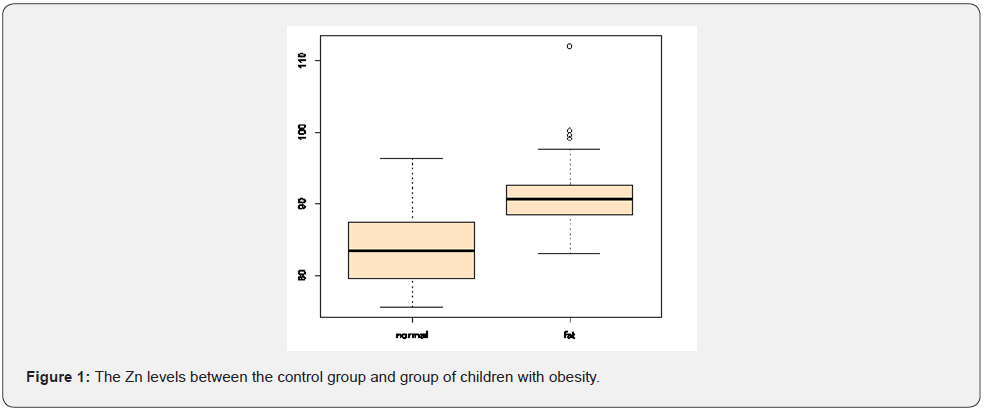
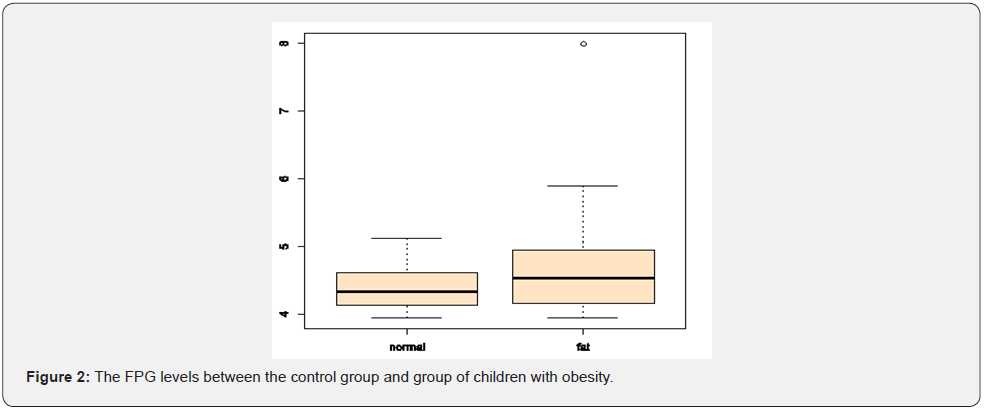
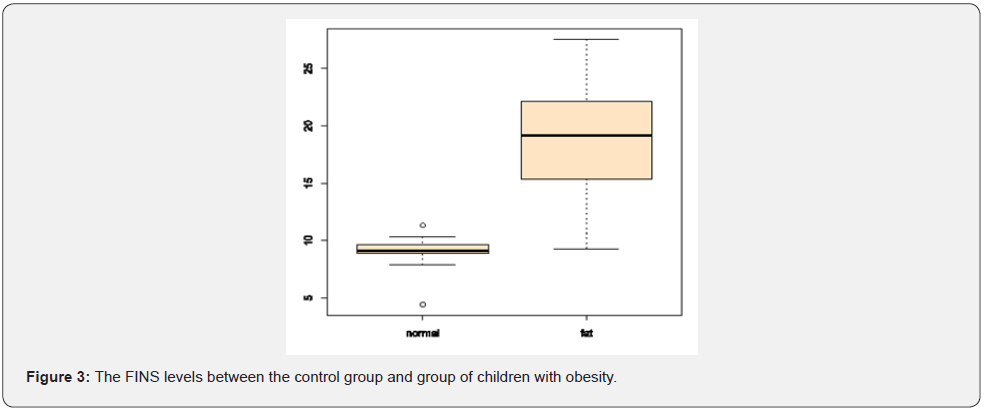
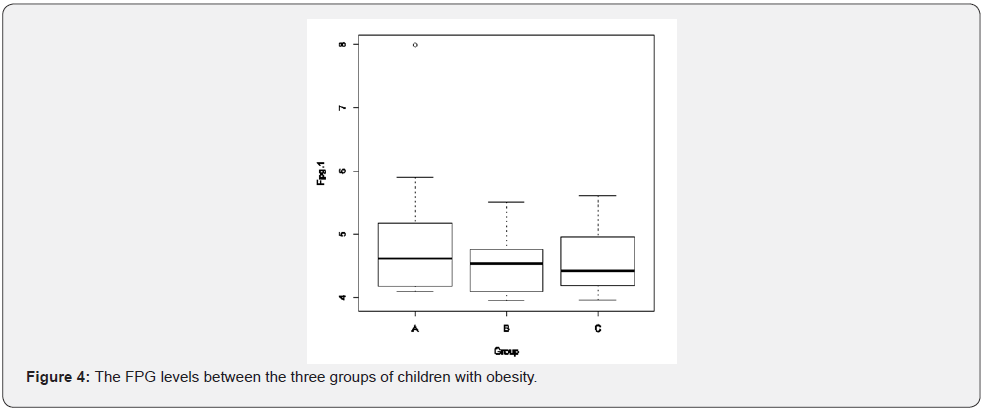
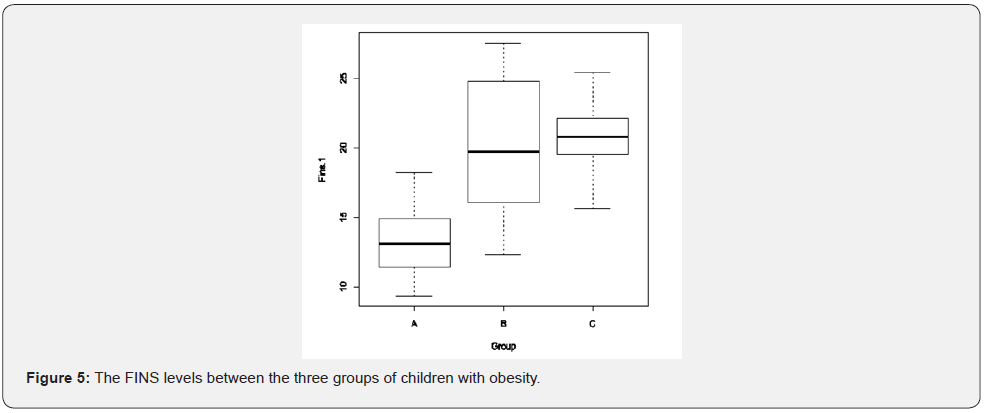
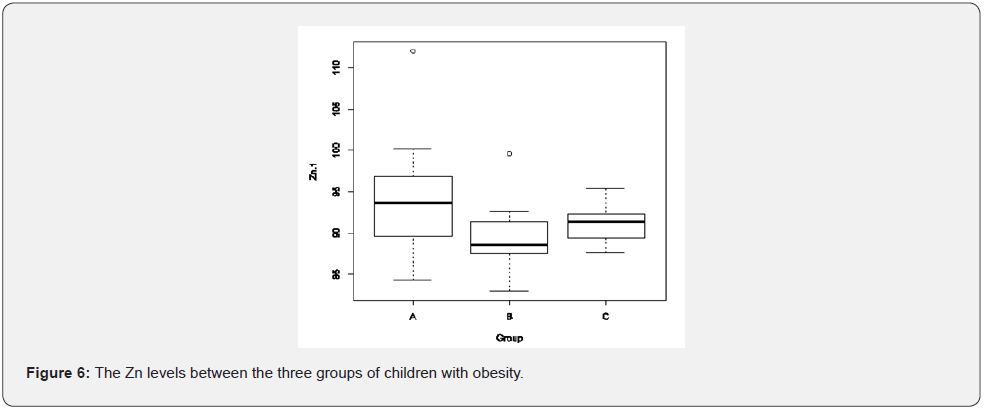
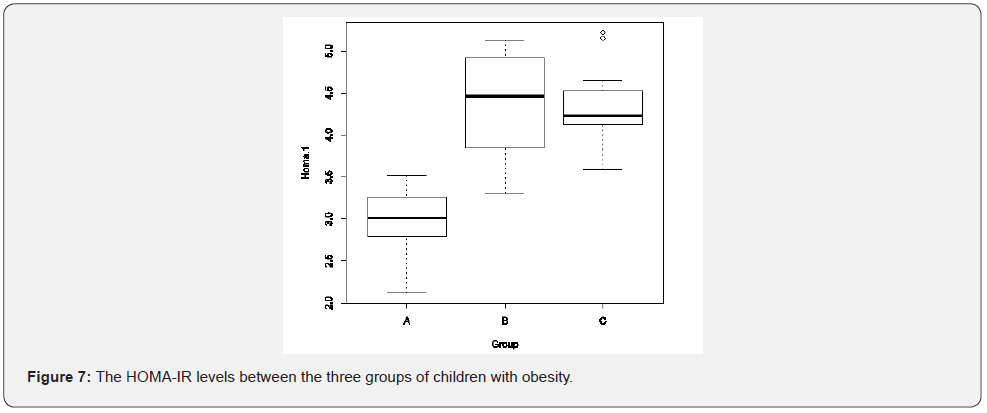

By multiple t-test, HOMA-IR and FINS showed significant difference between group A and other groups (P < 0.0001 for both), and no statistical significance between group B and C (P>0.05 for both). Zn showed significant difference between group A and other groups (P<0.01) and no statistical significance between group B and C (P>0.05). There was no statistical significance of the difference in FPG level between any group p>0.05).
Discussion

Zinc is essential for the correct packing and storage of insulin. In pancreatic β cells, Zinc and insulin form insoluble Zn-insulin complex in dense core vesicles (DCVs) [9,10]. In response to physiological stimuli such as increased blood glucose, Zinc receptor proteins control a variety of genes in Zn-dependent manner and the release of insulin. In this study, the serum Zn level in children with obesity was significantly higher than that of the control group. The difference was statistically significant. This is in contrast to the study of Di Martion et al. [11] which showed lower serum Zn level in people with obesity than normal control. There were also studies suggesting that the difference in Zn levels between children with mild obesity and normal control group was not statistically significant. The difference in Zn level was only statistically significant between children with moderate to severe obesity and normal control group. The different conclusion is likely due to difference in the severity of obesity and changes of blood glucose metabolism between our study and other studies. When compared with the control group, we showed no statistically significant difference in the FPG levels, but FNIS and HOMA-IR showed higher levels in children with obesity, indicating that insulin resistance is common in children with obesity (Table 2).
We further divided children with simple obesity into three groups based on the duration of obesity, and determined the relationship between Zn, FPG, FINS and HOMA-RA with different duration of obesity. The duration of obesity was divided into three groups, group A with duration of obesity <2.75 years: group B with duration of obesity 2.75~5 years, and group C with duration of obesity >5 years. The average HOMA-IR of group A, B and C was >2.69. When the duration of obesity was over 2.75 years, the frequency of HOMA-IA abnormality in children with obesity was significantly higher, and the level of Zn trended downward, while the levels of FINS and HOMA-IR trended upward. The difference of the levels of FINS and HOMA-IR between group A and Group B, C was statistically significant. The level of FPG was not increased. To maintain the normal level of FPG, the metabolism of Zn apparently was changed and the secretion of FINS was increased, which led to increased insulin resistance. This cycle gradually leads to decreased glucose tolerance and development of diabetes mellitus. Zinc and insulin participate in multiple different metabolisms, the relationship between Zinc and insulin is complex. Further studies are required to understand the mechanism of duration of obesity, Zinc and glucose metabolism.
Funding
There was no funding of the project.
Ethical Approval
The study was approved by the Institutional Review Boards of The Fifth Affiliated Hospital, Zhengzhou University.
References
- Hales CM, Carroll MD, Fryar CD, Ogden CL (2017) Prevalence of Obesity Among Adults and Youth: United States, 2015-2016. NCHS Data Brief (288): 1-8.
- Gower E, Estes C, Blach S, Razavi-Shearer K, Razavi H (2014) Global epidemiology and genotype distribution of the hepatitis C virus infection. J Hepatol 61(1 Suppl): S45-57.
- Rosa Luciano, Blegina Shashaj, Maria Rita Spreghini, Andrea Del Fattore, Carmela Rustico, et al. (2017) Percentiles of serum uric acid and cardiometabolic abnormalities in obese Italian children and adolescents. Ital J Pediatr 43(3): 3.
- Stanhope KL (2016) Sugar consumption, metabolic disease and obesity: The state of the controversy. Crit Rev Clin Lab Sci 53: 52-67.
- Yakoob MY, Lo CW (2017) Nutrition (Micronutrients) in Child Growth and Development: A Systematic Review on Current Evidence, Recommendations and Opportunities for Further Research. J Dev Behav Pediatr 38(8): 665-679.
- Marreiro DN, Fisberg M, Cozzolino SM (2002) Zinc nutritional status in obese children and adolescents. Biol Trace Elem Res 86(2): 107-122.
- Gu K, Xiang W, Zhang Y, Sun K, Jiang X (2018) The association between serum zinc level and overweight/obesity: a meta-analysis. Eur J Nutr 58(8): 2971-2982.
- Garcia OP, Ronquillo D, Marina del Carmen Caamano M, Guadalupe Martínez, Mariela Camacho, et al. (2013) Zinc, iron and vitamins A, C and e are associated with obesity, inflammation, lipid profile and insulin resistance in Mexican school-aged children. Nutrients 5(12): 5012-5030.
- Gavrilova J, Tougu V, Palumaa P (2014) Affinity of zinc and copper ions for insulin monomers. Metallomics 6(7): 1296-1300.
- O'Halloran TV, Kebede M, Philips SJ, Attie AD (2013) Zinc, insulin, and the liver: a menage a trois. J Clin Invest 123: 4136-4139.
- Di Martino G, Matera MG, De Martino B, Vacca C, Di Martino S, et al. (1993) Relationship between zinc and obesity. J Med 24(2-3): 177-183.






























